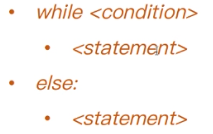1、赋值
1.1、变量在首次赋值时创建 ,在被引用前必须赋值
x,y ='china','beijing'
print(x,y)
x = y ='china'
print(x,y)
x,y ='SL'
print(x,y)
((x,y),z) = 'SL','xy' #特殊用法
print(x,y,z)
x = 1
y = 2
x,y =y,x #常用用法
print(x,y)
输出:
china beijing
china china
S L
S L xy
2 11.2、print与重定向
import sys
previous = sys.stdout
sys.stdout = open('temp.txt','a')
print('welcome')
sys.stdout.close()
sys.stdout = previous
print('welcome')
输出:
在文件temp.txt里显示welcome
welcome1.3、真值判断
None, False, 0, 0.0, [], (), {} 都是False 其他都为True
or 找到第一个真值则结束,短路操作,如果没有真值,则返回最后的值
and 如果是真会往右找,直到找到的为flase为止,如果没有,则返回最后的值
x = 2 or 3
print(x)
x = 2 and 3
print(x)
x = None or 2
print(x)
x = [] or ()
print(x)
x = 3 and []
print(x)
输出:
2
3
2
()
[]2、if else
2.1、基本用法说明

依次执行每一个测试,只要一个满足就执行对应的语句,执行完后结束
x = 'china'
if x == 'us':
print('us')
elif x == 'china':
print('india')
elif x =='china':
print('china')
else:
print('no match')
输出:
india2.2、其他的表示


3、while

4、break、contine、pass
break 跳出最近的循环
contine 跳出此次循环,继续下一次
pass 空位占位符,什么事情也不做
i = 0
while True:
if i > 4:
break
i += 1
print(i, end=',')
print('\n')
j = 0
while j < 10:
j += 1
if j < 6:
print(j, end=',')
else:
continue
print('***')
print('\n')
k = 0
while k < 10:
k += 1
if k < 6:
print(k, end=',')
else:
pass
print('***')
输出:
1,2,3,4,5,
1,2,3,4,5,
1,2,3,4,5,***
***
***
***
***5、for
可以遍历任何有序的序列对象内的元素 ,字符串、列表、元组、其他可迭代内置对象

for x in {1:'key1',2:'key2'}:
print(x)
for x in {1:'key1',2:'key2'}.items():
print(x)
输出:
1
2
(1, 'key1')
(2, 'key2')for i in range(1,10,2): # 起始 结尾 步长
print(i)
输出:
1
3
5
7
9
6、迭代器
6.1、类型介绍
内置可迭代对象:list 、 tuple 、 dict 、 set 、 str 等
可以使用 isinstance() 判断一个对象是否是 Iterable对象
import collections
print(isinstance([], collections.Iterable))
输出:
True参考:https://www.cnblogs.com/python-road/p/10504474.html
凡是可作用于 for 循环的对象都是 Iterable 类型;
凡是可作用于 next() 函数的对象都是 Iterator 类型
集合数据类型如 list 、 dict 、 str 等是 Iterable 但不是 Iterator ,不过可以通过 iter() 函数获得一个 Iterator 对象
from collections import Iterable
a=[1,2,4,6,8,6,10]
a=iter(a)
print(next(a))
print(next(a))
print(next(a))
输出:
1
2
4
迭代器方法:
6.2、range
for i in range(5):
print(i,end=',')
输出:
0,1,2,3,4,6.3、map 映射
map()会根据提供的函数对指定序列做映射。
参考:https://www.runoob.com/python/python-func-map.html
def square(x):
return x ** 2
a = map(square,[1,2,3,4,5])
print(list(a))
输出:
[1, 4, 9, 16, 25]6.3、enumrate 枚举
for i in enumerate(range(5,10)):
print(i,end=',')
for index,value in enumerate(range(5,10)):
print('index=%d => %d' %(index,value))
输出:
(0, 5),(1, 6),(2, 7),(3, 8),(4, 9),
index=0 => 5
index=1 => 6
index=2 => 7
index=3 => 8
index=4 => 9 6.4、sorted 排序
更加详细请参考:https://www.runoob.com/python/python-func-sorted.html
D = [3,4,6,3,0,7]
D1 = sorted(D)
print(D1)
输出:
[0, 3, 3, 4, 6, 7]6.5、sum、min、max
D = [3,4,5,6,7]
print(sum(D))
print(min(D))
print(max(D))
输出:
25
3
76.6、zip
zip()函数用于将可迭代的对象作为参数,将对象中对应的元素打包成一个个元组,然后返回由这些元组组成的列表。
参考:https://www.runoob.com/python/python-func-zip.html
https://www.cnblogs.com/wushuaishuai/p/7766470.html
zip 与zip(*)相当于压缩和解压缩的过程
a = [1,2,3,4,5]
c = [4,5,6,7]
b = list(zip(a,c))
print(b)
print(type(b))
d = zip(*b) #b的类型要是list,不是zip
print(list(d))
输出:
[(1, 4), (2, 5), (3, 6), (4, 7)]
<class 'list'>
[(1, 2, 3, 4), (4, 5, 6, 7)]
a = [1,2,3,4,5]
c = [4,5,6,7]
b = zip(a,c)
d = zip(*b)
print(list(d))
输出:
[(1, 2, 3, 4), (4, 5, 6, 7)]6.7、列表解析
D = [3,4,5,6,7]
D1 = []
for item in D:
D1.append(item *2)
print(D1)
D1 = [item *2 for item in D] #注意这种用法
print(D1)
输出:
[6, 8, 10, 12, 14]
[6, 8, 10, 12, 14]
6.8、文件迭代器
fp = open('temp.txt')
print(fp.readline()) #特别注意:每一行后还有一个换行符\n
print('----')
print(fp.readline())
print('----')
print(fp.readline())
print('----')
fp = open('temp.txt')
for line in fp:
print(line)
输出:
ni
----
hao
----
ma
----
ni
hao
ma7、文档
7.1、注释

7.2、dir函数
查看对象,模块等属性
a = []
print(dir(a))7.3、文档字符串 __doc__
def cluster():
"""
cluster is a method to get many nodes information
"""
pass
print(cluster.__doc__)
输出:
cluster is a method to get many nodes information






















 5238
5238











 被折叠的 条评论
为什么被折叠?
被折叠的 条评论
为什么被折叠?








